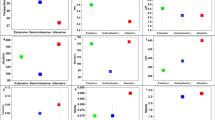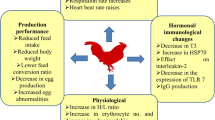Abstract
One-humped camels (Camelus dromedarius) exhibit remarkable adaptability to harsh desert environments through various physiological adaptations. This study aimed to assess variations and reference values of Heat-shock proteins (HSPs), physiological parameters, mineral concentrations, total antioxidant capacity (TAC), and malondialdehyde (MDA) in 90 healthy female one-humped camels from Zabol’s outskirts in Iran. The objective was to understand how these camels adapt to heat stress. Blood samples were collected from camels located at five geographical regions and analyzed using standard kits and methods. Reference intervals for heat-shock protein 30 (HSP30), heat-shock protein 40 (HSP40), heat-shock protein 70 (HSP70), and heat-shock protein 90 (HSP90) were determined using the reference value advisor (RVA). The study found significant differences among different regions for HSPs (P < 0.05), MDA (P = 0.021), and TAC (P = 0.042) levels, indicating variations in adaptation mechanisms. However, no notable differences were observed for other measured parameters between these regions. There were no significant differences observed in the evaluated parameters between the age categories of > 36 months and < 36 months. The positive correlation between HSPs and MDA levels (ranging from 0.754 to 0.884) suggests that the synthesis of HSPs is triggered as a response to oxidative stress caused by an imbalance between the production of reactive oxygen species (ROS) and the body’s antioxidant defenses. This oxidative stress, in turn, is a consequence of thermal stress. Additionally, the study reveals a negative association between TAC and HSP levels (ranging from − 0.660 to − 0.820), emphasizing the role of antioxidants in mitigating heat stress. The findings of this research offer compelling support for the critical role that HSPs play in protecting cells from heat-induced damage. Additionally, the presence of higher levels of HSPs in regions with more severe climate conditions serves as evidence of camels’ adaptation to heat stress. These findings emphasize the substantial impact of environmental factors on HSP production and further reinforce the crucial role of HSPs in bolstering the resilience of camels. Further research is needed to explore HSP expression and mechanisms to effectively manage and enhance camel resilience in extreme temperatures.




Similar content being viewed by others
Data availability
Data will be made available on resealable request.
References
Akan, Ö. Y., Ortan, P., & Hoşgörler, F., 2019. Role of HSP in the treatment of internal diseases. In Heat shock proteins (pp. 273–303). https://doi.org/10.1007/978-3-030-24285-5_16
Archana, P.R., Aleena, J., Pragna, P., Vidya, M.K., Niyas, A.P.A., Bagath, M., Krishnan, G., Manimaran, A., Beena, V., Kurien, E.K. and Sejian, V., 2017. Role of heat shock proteins in livestock adaptation to heat stress. J Dairy Vet Anim Res, 5(1), 00127.
Burtis, C.A, Ashwood, E.R., Bruns, D.E, 2006. Tietz Textbook of Clinical Biochemistry and Molecular Diagnostics. Fourth Ed. Elsevier, Saunders.
Chaudhury, S., Keegan, B.M. and Blagg, B.S., 2021. The role and therapeutic potential of Hsp90, Hsp70, and smaller heat shock proteins in peripheral and central neuropathies. Medicinal Research Reviews, 41(1), 202-222.
Elrobh, M.S., Alanazi, M.S., Khan, W., Abduljaleel, Z., Al-Amri, A. and Bazzi, M.D., 2011. Molecular cloning and characterization of cDNA encoding a putative stress-induced heat-shock protein from Camelus dromedarius. International Journal of Molecular Sciences, 12(7), 4214-4236.
Evgen’ev, M.B., Garbuz, D.G. and Zatsepina, O.G., 2005. Heat shock proteins: functions and role in adaptation to hyperthermia. Russian Journal of Developmental Biology, 36, 218-224.
Evgen’ev, M.B., Garbuz, D.G., Shilova, V.Y. and Zatsepina, O.G., 2007. Molecular mechanisms underlying thermal adaptation of xeric animals. Journal of Biosciences, 32, 489-499.
Faye, B., & Bengoumi, M., 2018. Camel clinical biochemistry and hematology (pp. 173-216). Cham (Switzerland): Springer.
Garbuz, D.G., Astakhova, L.N., Zatsepina, O.G., Arkhipova, I.R., Nudler, E. and Evgen’ev, M.B., 2011. Functional organization of hsp70 cluster in camel (Camelus dromedarius) and other mammals. PLoS One, 6(11), e27205.
Gaughan, J.B., 2011. Which physiological adaptation allows camels to tolerate high heat load–and what more can we learn. J. Camelid Sci, 4, 85-88.
Geffré, A., Concordet, D., Braun, J.P. and Trumel, C., 2011. Reference Value Advisor: a new freeware set of macroinstructions to calculate reference intervals with Microsoft Excel. Veterinary Clinical Pathology, 40(1), 107-112.
Ghosh, S., Sarkar, P., Basak, P., Mahalanobish, S., & Sil, P. C., 2018. Role of heat shock proteins in oxidative stress and stress tolerance. In Heat shock proteins (pp. 109–126).https://doi.org/10.1007/978-3-319-90725-3_6
Gomez, C.R., 2021. Role of heat shock proteins in aging and chronic inflammatory diseases. Geroscience, 43(5), 2515-2532.
Haak, J. L., Buettner, G. R., Spitz, D. R., & Kregel, K. C., 2009. Aging augments mitochondrial susceptibility to heat stress. American Journal of Physiology-Regulatory, Integrative and Comparative Physiology, 296(3), 812-820.
Hall, D.M., Xu, L., Drake, V.J., Oberley, L.W., Oberley, T.D., Moseley, P.L. and Kregel, K.C., 2000. Aging reduces adaptive capacity and stress protein expression in the liver after heat stress. Journal of Applied Physiology, 89(2), 749-759.
Horowitz, G.L., Altaie, S., Boyd, J.C., Ceriotti, F., Garg, U., Horn, P., Zakowski, Z., 2008. Defining, establishing, and verifying reference intervals in the clinical laboratory; approved guideline—CLSI document C28-A3, Third edn. Clinical and Laboratory Standards Institute, Wayne
Hoter, A., Amiri, M., Prince, A., Amer, H., Warda, M. and Naim, H.Y., 2018. Differential glycosylation and modulation of camel and human HSP isoforms in response to thermal and hypoxic stresses. International journal of molecular sciences, 19(2), 402.
Hoter, A., Rizk, S. and Naim, H.Y., 2019. Cellular and molecular adaptation of Arabian camel to heat stress. Frontiers in Genetics, 10, 588.
Jeyachandran, S., Chellapandian, H., Park, K., & Kwak, I. S. (2023). A Review on the Involvement of Heat Shock Proteins (Extrinsic Chaperones) in Response to Stress Conditions in Aquatic Organisms. Antioxidants, 12(7), 1444.
Jin, X., Wang, R., Xiao, C., Cheng, L., Wang, F., Yang, L., Feng, T., Chen, M., Chen, S., Fu, X. and Deng, J., 2004. Serum and lymphocyte levels of heat shock protein 70 in aging: a study in the normal Chinese population. Cell Stress & Chaperones, 9(1), 69.
Julier, Z., Park, A. J., Briquez, P. S., & Martino, M. M., 2017. Promoting tissue regeneration by modulating the immune system. Acta Biomaterialia, 53, 13-28.
Kalmar, B. and Greensmith, L., 2009. Induction of heat shock proteins for protection against oxidative stress. Advanced Drug Delivery Reviews, 61(4), 310-318.
Konstantinova, E.V., Chipigina, N.S., Shurdumova, M.H., Kovalenko, E.I. and Sapozhnikov, A.M., 2019. Heat shock protein 70 kDa as a target for diagnostics and therapy of cardiovascular and cerebrovascular diseases. Current Pharmaceutical Design, 25(6), 710-714.
Kurashova, N.A., Madaeva, I.M. and Kolesnikova, L.I., 2020. Expression of HSP70 heat-shock proteins under oxidative stress. Advances in Gerontology, 10, 20-25.
Lopez, V., III., 2018. Circulating heat shock protein responses during exercise in a hot and humid environment. Digital Commons @ UConn. https://digitalcommons.lib.uconn.edu/gs_theses/1216/
Melvin, Z.E., Dhirani, H., Mitchell, C., Davenport, T.R., Blount, J.D. and Georgiev, A.V., 2022. Methodological confounds of measuring urinary oxidative stress in wild animals. Ecology and Evolution, 12(7), e9115.
Molainia, M.R., Rezaee, M., Bostani, M., Hosseinabadi, H. and Khaksefidi, S., 2014. Zoning some extreme climate events in Sistan & Baluchistan province in the period 1371-1391. Advances in Natural and Applied Sciences, 8(7), 910-915.
Omidi, A., Sajedi, Z., Montazer Torbati, M.B. and Ansari Nik, H., 2014. Lipid profile and thyroid hormone status in the last trimester of pregnancy in single-humped camels (Camelus dromedarius). Tropical Animal Health and Production, 46, 609-614.
Omidi, A., Sajedi, Z.H., Montazer Torbati, M. and Mostafai, M., 2014. Metabolic profile of pregnant, non-pregnant and male two humped camels (Camelus bactrianus) of Iran. Iranian Journal of Veterinary Medicine, 8(4), 235-242.
Omidi, A., Fathi, M.H. and Asiaban, M., 2015. Elevated levels of blood urea nitrogen and creatinine in the last trimester of pregnancy of dromedary camels (Camelus dromedarius). Iranian Journal of Veterinary Medicine, 9(4), 249-255.
Saadeldin, I.M., Swelum, A.A.A., Elsafadi, M., Mahmood, A., Osama, A., Shikshaky, H., Alfayez, M., Alowaimer, A.N. and Magdeldin, S., 2020. Thermotolerance and plasticity of camel somatic cells exposed to acute and chronic heat stress. Journal of Advanced Research, 22, 105-118.
Saligeh, M., Bareimanei, F. and Esmaeilnegad, M., 2008. Climatical Regionalization on Sistan & Balouchestan Province. Geography and Development Iranian Journal, 6(12), 101-106.
Silver, J.T. and Noble, E.G., 2012. Regulation of survival gene hsp70. Cell Stress and Chaperones, 17, 1-9.
Sonna, L.A., Fujita, J., Gaffin, S.L. and Lilly, C.M., 2002. Invited review: effects of heat and cold stress on mammalian gene expression. Journal of Applied Physiology, 92(4), 1725-1742.
Szyller, J. and Bil-Lula, I., 2021. Heat shock proteins in oxidative stress and ischemia/reperfusion injury and benefits from physical exercises: a review to the current knowledge. Oxidative Medicine and Cellular Longevity, 2021, 1-12
Tabari, H., Talaee, P.H., Nadoushani, S.M., Willems, P. and Marchetto, A., 2014. A survey of temperature and precipitation based aridity indices in Iran. Quaternary International, 345, pp.158-166.
Verma, A., Sumi, S., & Seervi, M., 2021. Heat shock proteins-driven stress granule dynamics: yet another avenue for cell survival. Apoptosis, 26(7-8), 371-384.
Wu, B., Gu, M.J., Heydari, A.R. and Richardson, A., 1993. The effect of age on the synthesis of two heat shock proteins in the hsp70 family. Journal of Gerontology, 48(2), 50-56.
Yeh, S. L., & Hou, Y. C., 2014. Glutamine and antioxidant potential in diabetes. In Diabetes: Oxidative stress and dietary antioxidants (pp. 121-128). Academic Press.
Zhang, M., Wang, D., Xu, X., & Xu, W., 2021. Evaluation of antioxidant property of heat shock protein 90 from duck muscle. Animal Bioscience, 34(4), 724.
Zininga, T., Ramatsui, L. and Shonhai, A., 2018. Heat shock proteins as immunomodulants. Molecules, 23(11), 2846.
Zügel, U. and Kaufmann, S.H., 1999. Role of heat shock proteins in protection from and pathogenesis of infectious diseases. Clinical Microbiology Reviews, 12(1), 19-39.
Acknowledgements
The authors would like to acknowledge the Animal Health Management Department of Shiraz University for their valuable comments.
Funding
The Vice Chancellor for Research at Shiraz University provided support for this work (Grant number: 97GCU1M235008).
Author information
Authors and Affiliations
Contributions
All authors contributed to the study’s conception and design. Arash Omidi, Saeed Nazifi, Mehdi Rasekh, and Nima Zare performed material preparation, data collection, and analysis. Arash Omidi wrote the first draft of the manuscript, and all authors commented on previous versions. All authors read and approved the final manuscript.
Corresponding author
Ethics declarations
Ethics approval
The experiment was performed under the approval of the state Committee on Animal Ethics, Shiraz University, Shiraz, Iran (IACUC no: 4687/64). Also, the European Council Directive (86/609/EC) recommendations of November 24, 1986, regarding protecting animals used for experimental purposes, were considered.
Informed consent
Informed consent is not applicable in this study.
Conflict of interest
The authors declare no competing interests.
Additional information
Publisher's Note
Springer Nature remains neutral with regard to jurisdictional claims in published maps and institutional affiliations.
Rights and permissions
Springer Nature or its licensor (e.g. a society or other partner) holds exclusive rights to this article under a publishing agreement with the author(s) or other rightsholder(s); author self-archiving of the accepted manuscript version of this article is solely governed by the terms of such publishing agreement and applicable law.
About this article
Cite this article
Omidi, A., Nazifi, S., Rasekh, M. et al. Heat-shock proteins, oxidative stress, and antioxidants in one-humped camels. Trop Anim Health Prod 56, 29 (2024). https://doi.org/10.1007/s11250-023-03876-x
Received:
Accepted:
Published:
DOI: https://doi.org/10.1007/s11250-023-03876-x




